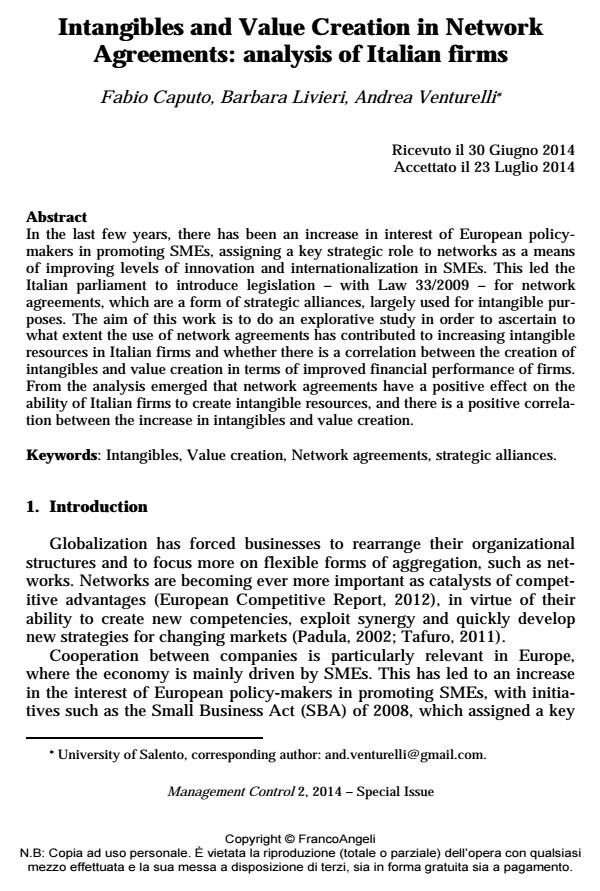Intangibles and Value Creation in Network Agreements: analysis of Italian firms
Journal title MANAGEMENT CONTROL
Author/s Fabio Caputo, Barbara Livieri, Andrea Venturelli
Publishing Year 2014 Issue 2014/2
Language English Pages 26 P. 45-70 File size 165 KB
DOI 10.3280/MACO2014-002003
DOI is like a bar code for intellectual property: to have more infomation
click here
Below, you can see the article first page
If you want to buy this article in PDF format, you can do it, following the instructions to buy download credits

FrancoAngeli is member of Publishers International Linking Association, Inc (PILA), a not-for-profit association which run the CrossRef service enabling links to and from online scholarly content.
In the last few years, there has been an increase in interest of European policymakers in promoting SMEs, assigning a key strategic role to networks as a means of improving levels of innovation and internationalization in SMEs. This led the Italian parliament to introduce legislation - with Law 33/2009 - for network agreements, which are a form of strategic alliances, largely used for intangible purposes. The aim of this work is to do an explorative study in order to ascertain to what extent the use of network agreements has contributed to increasing intangible resources in Italian firms and whether there is a correlation between the creation of intangibles and value creation in terms of improved financial performance of firms. From the analysis emerged that network agreements have a positive effect on the ability of Italian firms to create intangible resources, and there is a positive correlation between the increase in intangibles and value creation.
Keywords: Intangibles, Value creation, Network agreements, strategic alliances.
- Gender diversity and online intellectual capital disclosure: Evidence from Italian‐listed firms Giuseppe Nicolò, Giuseppe Sannino, Serena De Iorio, in Journal of Public Affairs e2706/2022
DOI: 10.1002/pa.2706 - La Network Governance a supporto dell'Open Innovation: un'analisi della letteratura Palmira Piedepalumbo, Concetta Metallo, Daniela Mancini, in MANAGEMENT CONTROL 3/2017 pp.79
DOI: 10.3280/MACO2017-003006 - Agglomeration, Structural Embeddedness, and Enterprises’ Innovation Performance: An Empirical Study of Wuhan Biopharmaceutical Industrial Cluster Network Jingjing Zeng, Dingjie Liu, Hongtao Yi, in Sustainability /2019 pp.3922
DOI: 10.3390/su11143922 - Measuring intellectual capital in a firm belonging to a strategic alliance Stefania Veltri, Andrea Venturelli, Giovanni Mastroleo, in Journal of Intellectual Capital /2015 pp.174
DOI: 10.1108/JIC-06-2014-0069 - Accounting Information Systems in an Open Society. Emerging Trends and Issues Daniela Mancini, in MANAGEMENT CONTROL 1/2016 pp.5
DOI: 10.3280/MACO2016-001001 - L'impatto del contratto di rete nei processi di internazionalizzazione: alcune evidenze empiriche sulle PMI italiane Andrea Venturelli, Fabio Caputo, Simone Pizzi, in MANAGEMENT CONTROL 2/2018 pp.61
DOI: 10.3280/MACO2018-002004 - The Relationship among Family Business, Corporate Governance, and Firm Performance: An Empirical Assessment in the Tourism Sector Rossella Leopizzi, Simone Pizzi, Fabrizio D'Addario, in Administrative Sciences /2021 pp.8
DOI: 10.3390/admsci11010008
Fabio Caputo, Barbara Livieri, Andrea Venturelli, Intangibles and Value Creation in Network Agreements: analysis of Italian firms in "MANAGEMENT CONTROL" 2/2014, pp 45-70, DOI: 10.3280/MACO2014-002003